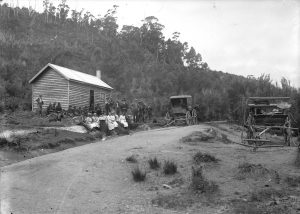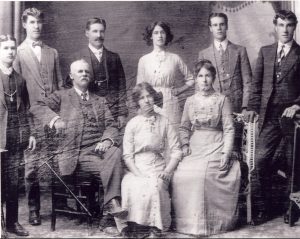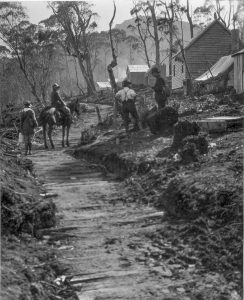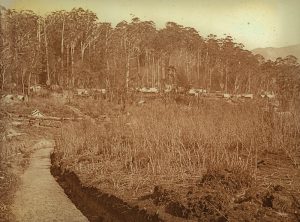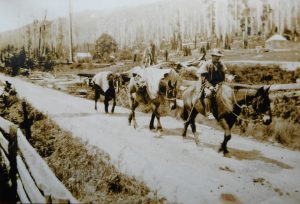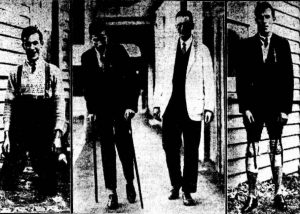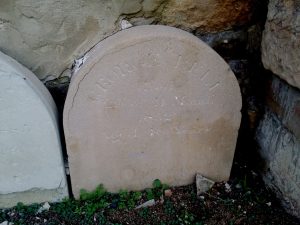
George Bell (1805–52) was born in Scotland and migrated to New South Wales on the barque Minerva in 1832, the voyage from Leith to Sydney lasting 5 months and 10 days, including a a stopover of more than three weeks in Hobart Town. Bell returned to live in Van Diemen’s Land with his new family in 1839.
George Bell diary Book 4
29/9/32 At 5 AM I got on deck & saw a range of rugged hills to the N with a large rock in the sea called the Mewstone some miles nearer us, but the weather prevented us making any progress during the day. On getting up the following morning we were off Tasman’s Head & entering Storm Bay with a fine breeze which left us as were abreast of Fluted Cape so called from its basaltic columns. By 11 the breeze freshened & we were passed Cape Fr Henry from whence we had a fine sail up to Hobart Town, during which I observed a man busy at his work mowing grass, so that I thought it no favorable [sic] specimen of the settlers observance of the Sabbath. After a voyage of 133 days from leaving Leith we cast anchor in Sullivan’s [sic] Cove, from which the town had a fine
p.153 appearance, & a small steamer passed us with passengers for the opposite shore of the Derwent. We brought the first intelligence of the passing of the Reform Bill to VD Land, I we had many visitants in the afternoon, mostly Scotchmen from one of whom Ballantyne of Glasgow I ascertained the circumstances of several individuals for whom I had letters, one of whom McLchose [sic] had lost all his goods recently in a vessel coming round from Launceston.
p.154 On 1/10/32 I first set foot on VD Land where I afterwards spent so many years. Having left the ship in company of Robertson the editor of “The Colonist” newspaper, he first took us to the Post office & then to his own house, where we had lunch. I had several parties to seek out & deliver letters & packets & messages to, from their friends & acquaintances in Scotland. Among others there were two females whom I had been accustomed to meet only in carpeted rooms, but their mothers death caused them to emigrate, & here in Hobart I found the eldest sitting as the mistress of a butcher’s stall, having married a butcher. The younger sister I met afterwards as a settlers [sic] wife in the country. Having found out a few other parties & dined at Robertson’s I went on board in the moonlight after spending a pleasant day. On the 3rd five of us crossed the river to Kangaroo Point, where we rambled in the bush, but saw only small birds to the disappointment of my comrades who had guns. I saw a
p.155 black snake coiled up at the foot of a tree, but hesitated to attack it till it saw me & made off. Having the loan of one of the guns I fired at a small bird & to my surprise I brot. it down, & found it of a yellowish tint. In our ramble we came to a cottage & the old man who lived in it showed us a hole in the wall which had been made the previous night while he was absent & the cottage robbed. I came upon another snake as I walked thro’ the bush & easily killed it with a stick. He was 3 ft 9 in long, of a yellowish color & of a poisonous species, with a black forked tongue. After a pleasant ramble, we dined in a tavern & got back to the ship before dark.
7th Several of us went ashore & attended the Burgher Meeting house & heard sermon from Macarthur on the Kingly character of Christ, but I was noways taken with the discourse. Some of our passengers having returned from New Norfolk, were delighted with the appearance of the country so that I arranged to set out on the 9th.
p.156 9/10/32 Soon after 7AM having got breakfast I started along with W Scott on the Launceston road, Hy Brock escorting us for a short distance. We found a good road & the country partially cultivated, with stone brick, & wooden houses at intervals till we reached a fine large stone house built for an Inn with a fine garden. This was Austin’s ferry & here we crossed the Derwent & which is here about ¾ mile broad. Being directed how to proceed we took our road thro’ the bush, but turned rather soon & came to a house & barns, about which we found no living creature so that we were quite at a loss. Going down a glen, we passed a cow & then a sawpit close to a small cave, until we were near the river. We then turned & going round the cultivated ground, rambled on in the heat of the day till it was past noon when we reached a wattle & daub cottage the door of which was opened by Amelia Beck, now Ross. She knew me at once she being sister to the butcher’s wife in Hobart & I was somewhat amused to see her walking in a pair of heavy shoes across
p.157 her mud floor which was not very even. Her husband a hale stout looking man about 40 soon came in from the ploughing & received us kindly. After dining on roast mutton &c Ross showed us over his farm He has 500 acres of his own 500 rented from a neighbour & 500 rented from Govt as a sheep run which he means to purchase. His farm is in a fine situation with a fine view from it a high picturesque basaltic rock called the Quoin forming a back fence to the land. On our return we had tea after which Amelia Ross played us a few tunes on her piano forte which she still retains. After a stroll in the moonlight & a chat by the fire, we retired to rest after walking about 20 miles in a fine warm day.
10th After an early breakfast we took leave of Amelia & her husband, & made our way back to the ferry, in crossing which we met a magistrate Gage who spoke well of Ross. Proceeding along the main road, at about 11 miles from Hobart we passed neat Barracks where a large chain gang are employed erecting a causeway
p.158 & bridge across the Derwent for the road to Launceston. Our road now lay along the bank of the river & we soon passed another gang who were burning lime. There were farms all along with inns at intervals. By 1PM we arrived at Elizabeth Town, where we enquired for the Bush Tavern, C Baker [Charles Barker] who seemed an agreeable smart young man. Here we remained for the night, walking in Baker’s fine garden & strolling thro’ the village which is mostly built of brick on a rising ground on the banks of the Derwent. The Lt Governor has a cottage in the vicinity & there is a church, jail, & hospital. Here we met with 2 of our shipmates who had started for Hamilton & got lost in the bush, which frightened them so that they come back as fast as they could, & made such a story of it that my companion took fright & said he would go no farther, at which I felt disappointed & annoyed, but I
p.159 was not easily turned from my purpose.
11th After a good nights rest we had breakfast & having settled the bill I took leave of my companion & by 9AM was put across the river in Baker’s boat when I took my road up towards Hamilton alone. I soon met a cart filled with skins of Kangaroo &c, drawn by six oxen going to market with a woman on the top, who said she was from Glasgow. Found houses all along with farms & gardens, which gave the country a pleasant appearance. I was hailed by an old man in the yellow garb of a convict, who took me for a constable & told me there was a bushranger hereabouts. This man had been in the 92d regt & all he had now to do was to supply a baker with firewood for his oven. Soon after noon I reached the Wool Pack Inn where I had some wine & rested till 1PM when I started for Downie’s. I soon reached fine
p.160 grass covered hills on which no trees had grown & continued my walk till I met an old shepherd T Burns who showed me Downie’s huts where I found the cook who supplied me with boiled mutton &c on which I dined. The cook having cleaned himself accompanied me across the country & we killed a snake 21 in in length. Crossing marshes & brooks, & pursuing our path along the side of hills thro’ trees till we came down to Wm Clelands by 4PM. Here his cook made tea for us & his master came home about 6 o’k when I went & met him with letter from his brother. He recognized my face & made many enquiries about old acquaintances. His calls his station Thornhill, being in the district of Macquarie Plains. The hut is of upright slabs with wide seams between, partly stuffed with wool. We retired to rest on wooden sofas covered with a mattrass [sic], & after about 20 miles walk I enjoyed a good nights rest.
p.161 12/10/32 After having bfast we were detained by rain till after 10 o’k when Cleland & I started with 3 Kangaroo dogs but unfortunately the spaniel followed us & by barking prevented our catching anything. C led the way thro’ the scrub on the lower part of the hills where the dogs started several Kangaroos one of which passed near me & I also had a view of a kangaroo rat running along. By 1PM we arrived at a stone cottage where Steel keeps an Overseer & some men. Here we dined on mutton &c with boiled flour pudding called ‘doeboy’. Saw the sinews drawn from the tails of two kangaroos which had been recently killed & they were presented to me. When thread was scarce, they have been used for sewing as well as for fiddle strings & other purposes. We then crossed a fine grass country to Downies who was gone to get his plough share repaired, so we followed on to the Woolpack Inn & here we found Downie sitting with the host
p.162 & his wife. D ordered dinner for me & after that they began to play cards which I took no part in, but occupied myself in reading an old No. of the Quarterly Review. They went on till 10.30 when they left, desiring me to go with them, but I preferred remaining where I was after walking about 20 miles. Downie has 1000 acres of land & about 7000 sheep, renting 7000 acres from Col Sorell for £350 a year.
13/10/32 After a sound sleep & a good bfast I found my cash was short, so I had to tell my landlady how it was. She said it did not matter but took the 4/4 dollar for the 6/-. 8.20 Started in a wet morning with my umbrella over me. The road was very deep in many places & the rain kept on till I was almost at Elizab town where I had to hallo to the ferry & get over, when I told Baker how it was with me & he made me welcome to the ferry. Called at Robertson’s & got a tea dinner but did not see him (Hector) as he was out Start again 1.20 & found the road pretty good so that I entered Hobart by 7 just as it is was dark. Called on one of our passengers & got tea
p.163 Met our Dr & went to the wharf with him & at 9 we got a boat to put us on board where I went to bed after a walk of 36 miles, finding a blister on one foot but I was much pleased with my trip on the whole.
14/10/32 Remained on board today & the Sarah brig arrived from Liverpool with passengers. I visited her on the 15th but made no stay. Took up this day mostly in writing & in the evening had another drunken squabble with old Cadell, but I was enabled to keep out of it. The following evening 16th he abused me when he was drunk, but I paid no attention to it. 17th We saw two men hanged on the gallows, from the ship, & I was shewn ‘The Times’ of yesterday containing the testimonial of the Passengers to the Capt’s good conduct.
18th Went ashore with Moat & walked thro’ the Paddock till we came to the Govt garden where we enquired for the Supt Davidson but he had gone to town however we were told to walk in which we did. It is situated on the banks of the Derwent & looks very well, altho’
p.164 not so nice as I should wish. There is an Eagle chained & 3 hives of bees, which are thriving well since imported. Adjoining the gardens we saw a pr of Pheasants, Kangaroos, Rabbits, a native Cat & a Devil as it is termed, also a black & blue bird, the size of a hen, which they styled a Balcoot. Leaving the garden we took our way over the hill to New Town where we saw a very pretty place of Owen’s a Magistrate. Passed a Haystack being the first I have seen. Reached the main road to Launceston & a little beyond the 3rd milestone we came to a white cottage where we found Fr Argo & his wife who made tea for us. He has got his forge nearly finished. Returned to town at the Fairbairns & called on TG Smith who shewed me his library.
p.165 My friend Cleland paid me a visit on the 20th & on the following day we were fairly under weigh for Sydney with a favorable [sic] breeze, passing Cape Pillar, so called from a pillar shaped rock, & the whole coast here has a singular appearance from is basaltic formation. Our ship made so much water than on the 23rd the Pump required to be worked every hour, but they afterwards managed to partly stop the leak so that we made less water. 22d We were in with the coast, very high land; & on 23d we were in sight of a high mountainous coast with flocks of a small black bird flying about. On the even of the 25th it began to blow & we had sight of the stormy Petrel for the first time since leaving the north seas. On the forenoon of the 27th I went up the main mast & touched the truck of the royal mast, a fate I had determined to accomplish if possible, but for which I was reproved, as being too rash in my case. [in the margin: ‘20/3/52’ (sic)]
